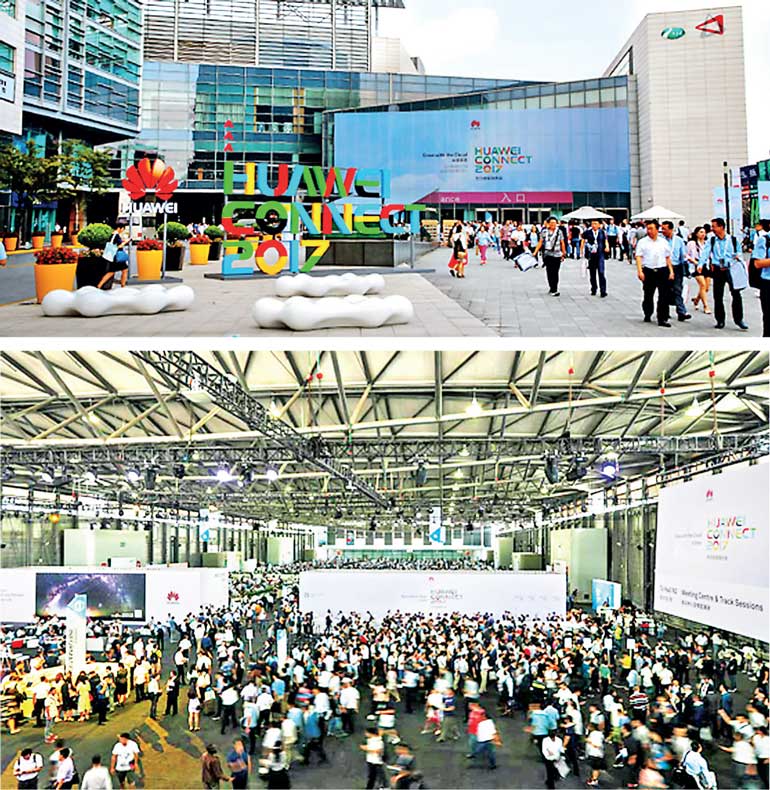Sunday Nov 30, 2025
Sunday Nov 30, 2025
Monday, 11 September 2017 00:00 - - {{hitsCtrl.values.hits}}
At the Huawei Connect 2017, Zheng Yelai, President of Huawei’s Cloud BU and President of the IT product line, updated attendees on the current progress of Huawei cloud business, and also unveiled Huawei’s innovative Enterprise Intelligence (EI) solution for the enterprise market.

Zheng Yelai, President of Huawei’s Cloud BU and President of the IT product line unveiled Huawei’s innovative Enterprise Intelligence (EI) solution for the enterprise market speaks at the Huawei Connect 2017 held in Shanghai last week
Enterprises have been carrying out digital transformation using cloud computing technology, and have now entered the value creation stage. Huawei believes that a cloud will prosper only when it helps customers create value on an ongoing basis. Artificial Intelligence (AI) is now widely recognised as a gold-mining engine, but AI research and application projects are more closely linked to single point AI techniques. These simple applications cannot satisfy the needs of many enterprises. In particular, the supply chain, manufacturing, and management systems of large- and medium-sized enterprises require more complex AI applications.
“The best cloud must be able to deliver the services that customers need, and AI needs to create more value for enterprises. To make this happen, we have to integrate single-point techniques and apply them, together, in sophisticated enterprise scenarios,” Zheng Yelai said.
“We’re positioning Huawei Cloud as an enabler of the intelligent world. It provides AI, IoT, computing, and storage capabilities that provide enterprises with more innovative, intelligent cloud services. Through Huawei Cloud, we are essentially exposing our most formative achievements and practices in R&D – which we’ve built up over many years – to governments, enterprises, partners, and developers.”
At Huawei Connect 2017, Huawei’s innovative EI made its international debut. It includes three types of intelligent cloud services and a heterogeneous computing platform. A summary of its features are:
Yang Xiaoling, CDO of China Pacific Insurance Company (CPIC), also spoke on the first day of the event. He shared CPIC’s experience using OCR technology to handle health insurance claims. Customers are able to take photos of their medical documents and upload the images to CPIC’s system, which will automatically read the documents and create structured claims documents to support the processing of the claim. An estimate suggests that the use of OCR technology will help CPIC cut labor costs by more than 50%. CPIC looks forward to working more closely with Huawei on image recognition and deep learning to develop the solutions that the insurance industry needs.

During the day, Li Qiang, Division Chief from the Shenzhen Traffic Police Bureau, also shared Shenzhen’s leading experience in intelligent urban transportation. By using Huawei’s AI platform, the Bureau is able to pre-filter traffic violations images, enabling a 10-fold increase in the image screening efficiency. The intelligent traffic solution jointly developed by Huawei and the Shenzhen Traffic Police Bureau was honoured with the ‘2017 Innovative Road Traffic Offering’ award from the Chinese Road Traffic Safety Association.
Thierry Bonhomme, CEO of Orange Business Services, a partner for Huawei’s public clouds, also updated attendees on Orange’s latest progress in the cloud service area. The European Organisation for Nuclear Research (CERN) has been running their workloads on the public cloud that was jointly developed by Huawei and Deutsche Telekom. Relying on thousands of Huawei’s high-performance computing nodes, CERN has lowered the overall maintenance costs of Large Hadron Collider (LHC) experiments by approximately 67% and shortened the online cycle from 90 to 15 days.
Zheng further elaborated on some of the core concepts that differentiate Huawei Cloud, including reliability and openness. He stated that Huawei is committed to becoming a neutral service provider. Since the Cloud BU’s formation in March 2017, it has seen a 238% increase in Huawei’s cloud user base, and has released 40 new cloud services, including the data warehouse service, advanced DDoS service, and CDN service. As of now, Huawei has released a total number of 85 cloud services. In the meantime, over 4,500 new features have been added to Huawei Cloud.
HUAWEI CONNECT 2017 was all about platforms and ecosystems, focusing on practical application and hands-on experience. This year’s event brought together members of the vast global ICT ecosystem in an interactive exhibition hall over 20,000 square meters in area, 30% larger than last year. Over 60 sponsors, 10 industry organisations, and 130 joint solution partners were present at the exhibition, and around 1,000 partners joined Huawei at the event. Major partners in attendance include SAP, Accenture, Chinasoft International, HGST, Intel, Microsoft, Centerm, and Infosys. They will jointly showcase their latest progress and best practices in ICT technology, and participate in a broad range of activities during the event, including keynotes, booth exhibitions, sponsor events, and technical sessions. Over 10 industry alliances, including the Cloud Native Computing Foundation (CNCF), Cloud Security Alliance (CSA), Beijing Disaster Backup and Recovery Technology and Industry Alliance, Edge Computing Consortium (ECC), GSMA, Industrial Internet Consortium, OpenSDS, and OpenStack, also attended.

At the conference, Huawei also officially announced the new domain name for Huawei Cloud: www.huaweicloud.com.